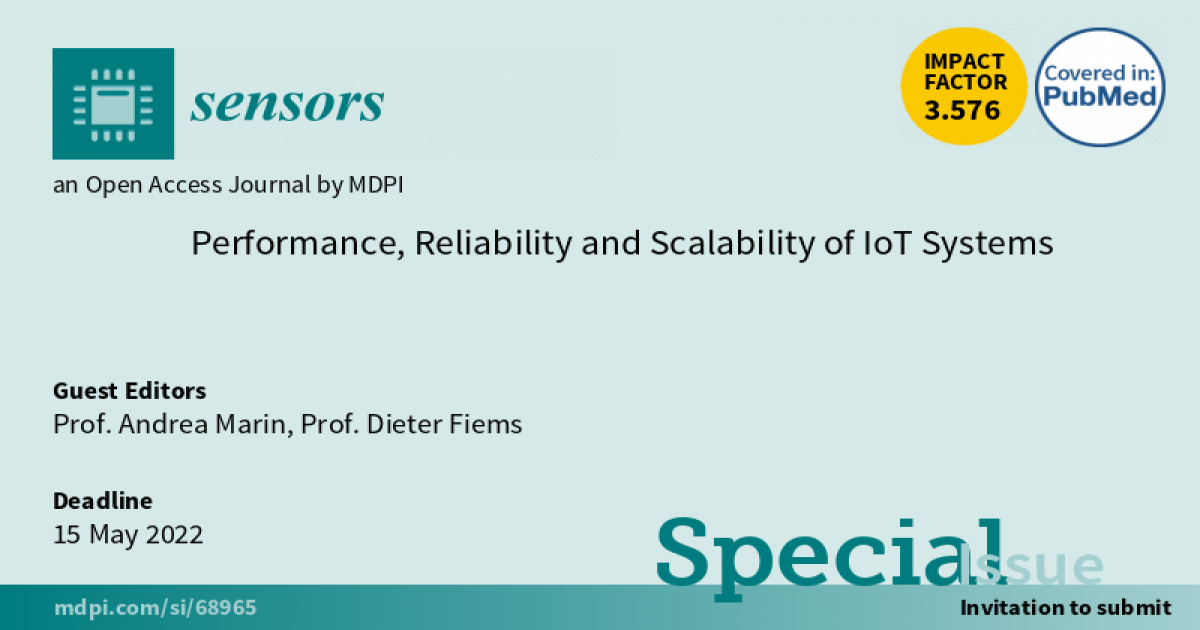Performance, Reliability and Scalability of IoT Systems
A special issue of Sensors (ISSN 1424-8220). This special issue belongs to the section "Internet of Things".
Deadline for manuscript submissions: closed (15 May 2022) | Viewed by 8941

Special Issue Editors
Interests: network modeling; performance evaluation; underwater sensor networks; simulation
Special Issues, Collections and Topics in MDPI journals
Special Issue Information
Dear Colleagues,
The development of IoT systems poses serious problems in terms of quality of service (QoS) assurance. The availability of massive amounts of data collected by heterogenous sensors, the need for their analysis, and the demand of quick reactions at the occurrence of certain events make the design of such systems quite challenging. In many cases, these requirements conflict with the need for low-cost and low-power consumption of most of the devices. Furthermore, the scalability of the devised solutions must be considered, since workloads may depend on many unpredictable factors that can generate peaks of resource demands. This can undermine the availability of the services due to saturation of the system’s service capacity.
For these reasons, performance and reliability modeling, analysis, and simulation as well as on-field measurements play crucial roles in the design of IoT systems.
This Special Issue welcomes either methodological, applicative or experimental contributions with respect (but not limited) to the following areas of interest:
- Performance and scalability of the communication protocols;
- Reliability of communication systems and of systems in general;
- Data offloading policies;
- Quantitative analysis of interactions with fog computing and cloud architectures;
- Workload characterization in IoT;
- Design of new energy-aware communication protocols for sensor nodes;
- Development of models for the early evaluation of IoT system performance and reliability properties.
Prof. Andrea Marin
Prof. Dieter Fiems
Guest Editors
Manuscript Submission Information
Manuscripts should be submitted online at www.mdpi.com by registering and logging in to this website. Once you are registered, click here to go to the submission form. Manuscripts can be submitted until the deadline. All submissions that pass pre-check are peer-reviewed. Accepted papers will be published continuously in the journal (as soon as accepted) and will be listed together on the special issue website. Research articles, review articles as well as short communications are invited. For planned papers, a title and short abstract (about 100 words) can be sent to the Editorial Office for announcement on this website.
Submitted manuscripts should not have been published previously, nor be under consideration for publication elsewhere (except conference proceedings papers). All manuscripts are thoroughly refereed through a single-blind peer-review process. A guide for authors and other relevant information for submission of manuscripts is available on the Instructions for Authors page. Sensors is an international peer-reviewed open access semimonthly journal published by MDPI.
Please visit the Instructions for Authors page before submitting a manuscript. The Article Processing Charge (APC) for publication in this open access journal is 2600 CHF (Swiss Francs). Submitted papers should be well formatted and use good English. Authors may use MDPI's English editing service prior to publication or during author revisions.
Keywords
- IoT
- performance evaluation
- reliability analysis
- sensor networks
- fog computing
Benefits of Publishing in a Special Issue
- Ease of navigation: Grouping papers by topic helps scholars navigate broad scope journals more efficiently.
- Greater discoverability: Special Issues support the reach and impact of scientific research. Articles in Special Issues are more discoverable and cited more frequently.
- Expansion of research network: Special Issues facilitate connections among authors, fostering scientific collaborations.
- External promotion: Articles in Special Issues are often promoted through the journal's social media, increasing their visibility.
- e-Book format: Special Issues with more than 10 articles can be published as dedicated e-books, ensuring wide and rapid dissemination.
Further information on MDPI's Special Issue polices can be found here.







